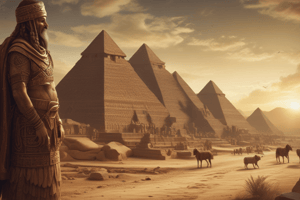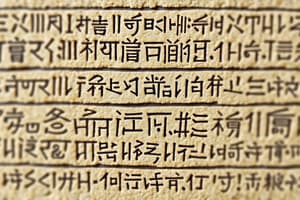Podcast
Questions and Answers
Which river is NOT associated with the development of Mesopotamian civilization?
Which river is NOT associated with the development of Mesopotamian civilization?
- Tigris
- Euphrates
- Nile (correct)
- None of the above
Mesopotamia is known as the 'Civilization of the Crescent' because of its crescent-shaped fertile land.
Mesopotamia is known as the 'Civilization of the Crescent' because of its crescent-shaped fertile land.
True (A)
Name one of the main cities of ancient Mesopotamia.
Name one of the main cities of ancient Mesopotamia.
Babylon
In Mesopotamian civilization, the king was responsible for maintaining __________ and protection of the poor.
In Mesopotamian civilization, the king was responsible for maintaining __________ and protection of the poor.
Match the following empires with their locations in Mesopotamia:
Match the following empires with their locations in Mesopotamia:
Which of the following cities was NOT one of the main cities in ancient Mesopotamia?
Which of the following cities was NOT one of the main cities in ancient Mesopotamia?
What role did the king in Mesopotamian society NOT fulfill?
What role did the king in Mesopotamian society NOT fulfill?
Which of the following regions was part of Mesopotamia?
Which of the following regions was part of Mesopotamia?
What characterized the urban planning of cities in ancient Mesopotamia?
What characterized the urban planning of cities in ancient Mesopotamia?
Which of the following statements about Mesopotamian civilization is true?
Which of the following statements about Mesopotamian civilization is true?
Flashcards are hidden until you start studying
Study Notes
Mesopotamian Civilisation Overview
- Originated approximately 6000 years ago, making it one of the oldest known civilisations.
- Located in the fertile region along the Tigris and Euphrates rivers, primarily in present-day Iraq.
Geographical Significance
- Referred to as the ‘Civilisation of the Crescent’ due to the crescent-shaped fertile land conducive to agriculture.
Major Regions
- Divided into several key areas:
- Sumer in the south
- Babylonia in the north
- Akkad at the center
- Assyria to the northeast
Historical Influence
- Rulers and empires adhered to the foundational Mesopotamian lifestyle until the conquest by Cyrus of Persia.
Key Cities
- Prominent urban centers included Babylon, Uruk, Eridu, Lagash, and Ur, each contributing to the region's cultural and economic activities.
Religious Structure
- Each city state had religious significance with massive temple towers known as Ziggurats dedicated to the worship of gods.
Urban Planning
- Despite grand constructions, cities lacked systematic urban planning, reflecting organic growth rather than engineered layout.
Social Hierarchy
- The king occupied the highest position in the social structure, overseeing governance and the welfare of the people.
- Below the king were priests, scribes, merchants, landowners, and craftsmen; prisoners, peasants, and slaves formed the lower strata of society.
King’s Responsibilities
- The king was primarily responsible for upholding justice and ensuring the protection of the underprivileged classes within the society.
Mesopotamian Civilisation Overview
- Originated approximately 6000 years ago, making it one of the oldest known civilisations.
- Located in the fertile region along the Tigris and Euphrates rivers, primarily in present-day Iraq.
Geographical Significance
- Referred to as the ‘Civilisation of the Crescent’ due to the crescent-shaped fertile land conducive to agriculture.
Major Regions
- Divided into several key areas:
- Sumer in the south
- Babylonia in the north
- Akkad at the center
- Assyria to the northeast
Historical Influence
- Rulers and empires adhered to the foundational Mesopotamian lifestyle until the conquest by Cyrus of Persia.
Key Cities
- Prominent urban centers included Babylon, Uruk, Eridu, Lagash, and Ur, each contributing to the region's cultural and economic activities.
Religious Structure
- Each city state had religious significance with massive temple towers known as Ziggurats dedicated to the worship of gods.
Urban Planning
- Despite grand constructions, cities lacked systematic urban planning, reflecting organic growth rather than engineered layout.
Social Hierarchy
- The king occupied the highest position in the social structure, overseeing governance and the welfare of the people.
- Below the king were priests, scribes, merchants, landowners, and craftsmen; prisoners, peasants, and slaves formed the lower strata of society.
King’s Responsibilities
- The king was primarily responsible for upholding justice and ensuring the protection of the underprivileged classes within the society.
Studying That Suits You
Use AI to generate personalized quizzes and flashcards to suit your learning preferences.



